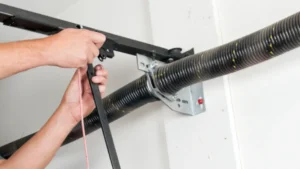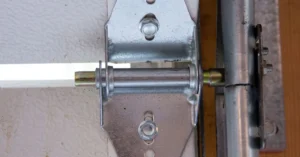A garage door usually works quietly in the background until the day it starts acting up. When the belt inside the opener begins to wear out, small problems can turn into big headaches. Spotting the early signs helps you schedule a garage door belt replacement at the right time and avoid getting stuck with a door that refuses to move.
Why the Garage Door Belt Matters
The Role of the Belt
Every time you leave for work or bring the car back in, the opener belt pulls the door with steady tension. Over months and years this tension slowly affects the material. Heat, weather changes, dust, and regular use all contribute to wear. Many homeowners never look at the belt directly, so its decline often goes unnoticed.
Wear That Sneaks Up
Small hints usually appear long before failure. A slight pause when moving up, a soft rattle, or a change in speed might show up one day and vanish the next, making them easy to ignore. Yet these signs often point toward the need for replacing belt on garage door opener setups before damage spreads to other parts.
Sign One New Sounds You Have Never Heard Before
Strange Noises Are a Warning
One of the first indicators is noise. A belt that is slipping or stretched starts making sounds you are not used to hearing. Maybe a soft whine. Maybe a clicking feel as the belt moves. Once I ignored a little squeak thinking it was nothing. The next morning the opener hummed but the door stayed down. That tiny squeak had been the only warning I got.
Why Noises Matter
When the belt loses tension, it rubs harder against the rail. This friction creates new sounds. A timely garage door opener belt replacement at this stage can stop the noise and protect the motor from extra strain.
Sign Two Slower Lifting or Shaky Movement
Performance Drops Before Failure
A garage door is supposed to glide. When you notice hesitation or shaking, the belt may not be gripping strongly enough. Sometimes the door climbs halfway and then speeds up or slows down on its own. This inconsistency usually points to belt wear.
A Safety Factor Too
A worn belt can cause the door to tilt or close unevenly. Besides being annoying, this can put pressure on the tracks and rollers. Replacing garage door belt components before the door jams keeps everything aligned and safe.
Sign Three Visible Cracks or Loose Fibers on the Belt
What You Might See
Shine a bright light along the belt. Look for cracked edges, glossy worn spots, or loose fibers. Sometimes little rubber pieces fall on the floor near the opener rail. These are physical signs that the belt’s strength is fading.
Why Appearance Should Not Be Ignored
When the belt develops surface cracks, it often means deeper damage has begun. Once weakened, the belt may snap unexpectedly. Planning a garage door belt replacement at this point is far better than dealing with a nonmoving door during rush hour.
Sign Four Increased Vibrations from the Opener
The Opener Should Not Shake
If the opener unit vibrates strongly when the door moves, the belt might be too loose. A loose belt causes the rail to wobble which sends vibrations through the whole opener.
Protecting Other Internal Parts
Ignoring this vibration may damage gears inside the opener housing. Those repairs cost much more than a simple belt installation. Replacing belt on garage door opener systems early keeps the motor steady and working longer.
Sign Five The Door Fails to Complete Its Travel
Stopping Halfway Is Not Normal
A belt that slips often makes the door stop before reaching the top or bottom. You might have to press the button twice or lift the door by hand. While misaligned sensors can cause similar issues, a worn belt is one of the most common reasons.
Why This Sign Is Serious
Once the opener struggles this much, the internal motor works harder than it is designed to. A quick garage door belt replacement avoids the risk of burning out the motor entirely.
Maintenance Tips to Reduce Belt Problems
Simple Routine Checks
With a few small habits you can slow down belt wear.
• Wipe dust from the rail regularly
• Watch for changes in speed or sound
• Check belt tension every few months
• Keep the opener area clean
When You Should Not DIY
Many homeowners look up how to replace garage door belt parts and feel confident at first. But the process requires precise alignment and correct tension. An improper setup can cause the door to lean or strain other parts. When unsure, calling a technician is wiser.

Frequently Asked Questions
How do I know if I truly need a garage door belt replacement
Listen for unusual sounds, watch for shaky movement, and check the belt for cracks. These clues show you when replacement is needed.
Is replacing garage door belt hardware safe to do on my own
Only if you are comfortable with tools and alignment steps. Many people prefer a professional because the tension settings matter a lot.
How long can a typical belt last
Most belts last seven to ten years. Homes that use the garage door many times a day may need replacement sooner.
Will a new belt make my opener quieter
Yes. A fresh belt runs smoother and reduces vibration, especially compared to older worn material.
Does replacing belt on garage door opener units improve efficiency
Absolutely. A new belt ensures steady pulling power and reduces stress on the motor.
Conclusion
If your garage door has been making new noises, slowing down, or showing visible belt damage, it is time to consider garage door belt replacement before small issues turn into breakdowns. For reliable help and a smooth working door, reach out to Apex Garage Doors Experts and get the job done with confidence.





